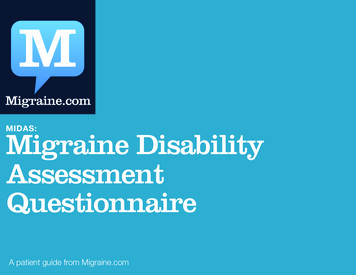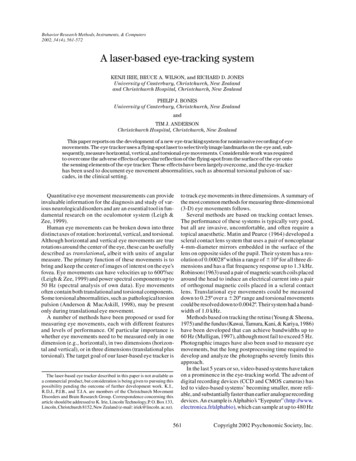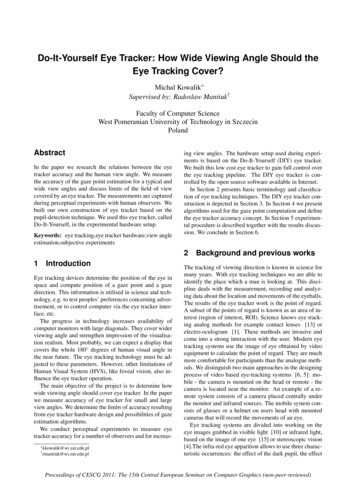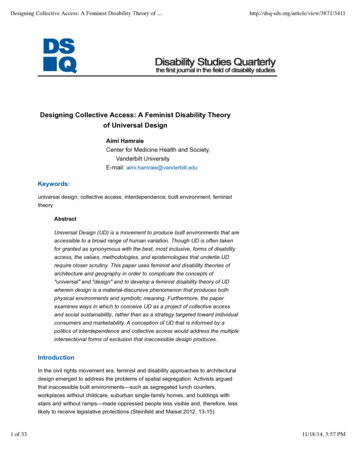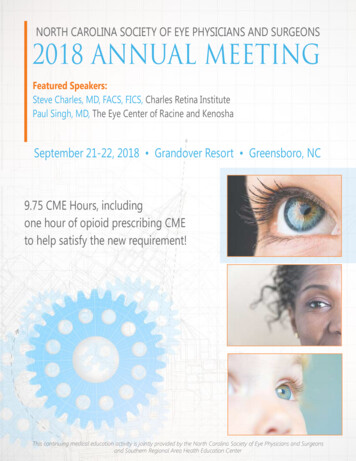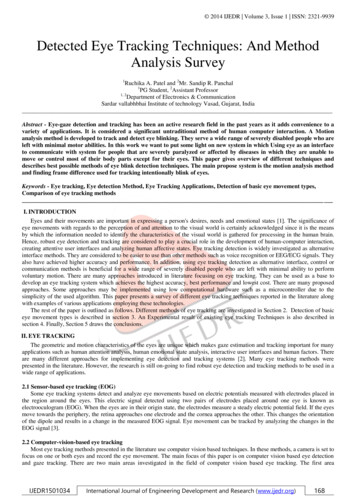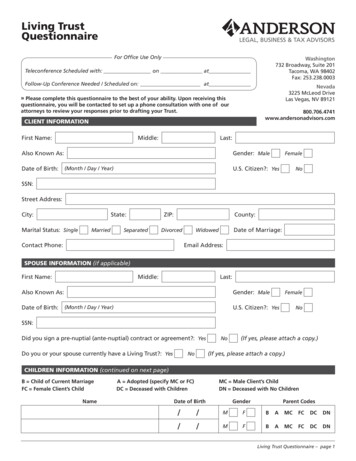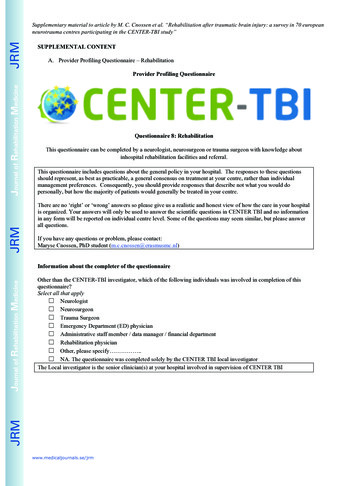
Transcription
EYE CONDITIONS DISABILITY BENEFITS QUESTIONNAIRENAME OF PATIENT/VETERANPATIENT/VETERAN'S SOCIAL SECURITY NUMBERIMPORTANT - THE DEPARTMENT OF VETERANS AFFAIRS (VA) WILL NOT PAY OR REIMBURSE ANY EXPENSES OR COST INCURRED IN THE PROCESS OFCOMPLETING AND/OR SUBMITTING THIS FORM.Note - The Veteran is applying to the U.S. Department of Veterans Affairs (VA) for disability benefits. VA will consider the information you provide on this questionnaire as partof their evaluation in processing the Veteran's claim. VA may obtain additional medical information, including an examination, if necessary, to complete VA's review of theveteran's application. VA reserves the right to confirm the authenticity of ALL questionnaires completed by providers. It is intended that this questionnaire will be completedby the Veteran's provider.NOTE: This examination must be conducted by a licensed ophthalmologist or by a licensed optometrist. The examiner must identify the disease, injury or otherpathologic process responsible for any decrease in visual acuity or other visual impairment found.Examinations of visual fields or muscle function should be conducted ONLY when there is a medical indication of disease or injury that may be associated with visual fielddefect or impaired muscle function. If indicated to address requested claim, and not medically contraindicated, dilated fundus exam required.Are you completing this Disability Benefits Questionnaire at the request of:Veteran/ClaimantOther: please describeAre you a VA Healthcare provider?YesNoYesIs the Veteran regularly seen as a patient in your clinic?Was the Veteran examined in person?YesNoNoIf no, how was the examination conducted?EVIDENCE REVIEWEvidence reviewed:No records were reviewedRecords reviewedPlease identify the evidence reviewed (e.g. service treatment records, VA treatment records, private treatment records) and the date range.Eye Conditions Disability Benefits QuestionnaireReleased January 2022Updated on: April 1, 2020 v20 1Page 1 of 12
SECTION I - DIAGNOSISNOTE: The diagnosis section should be filled out AFTER the clinician has completed the examination.1A. DOES THE VETERAN CURRENTLY HAVE AN EYE CONDITION (other than congenital or developmental errors of refraction)?YESNO(If "Yes," provide only diagnoses that pertain to eye conditions:)DIAGNOSIS # 1 -ICD CODE -DATE OF DIAGNOSIS -DIAGNOSIS # 2 -ICD CODE -DATE OF DIAGNOSIS -DIAGNOSIS # 3 -ICD CODE -DATE OF DIAGNOSIS -1B. IF THERE ARE ADDITIONAL OR PRIOR DIAGNOSES THAT PERTAIN TO EYE CONDITIONS, LIST USING ABOVE FORMAT:SECTION II - MEDICAL HISTORY1. DESCRIBE THE HISTORY (including onset and course) OF THE VETERAN'S CURRENT EYE CONDITION(S) (Brief summary):SECTION III - PHYSICAL EXAMINATION1. VISUAL ACUITYVisual acuity should be reported according to the lines on the Snellen chart or its equivalent. If assessment of the veteran's visual acuity falls between two lines on theSnellen chart, round up to the higher (worse) level (poorer vision) for answers a-d below. (For example, 20/60 would be reported as 20/70; 20/80 would be reported as20/100. etc.)Examination of visual acuity must include central uncorrected and corrected visual acuity for distance and near vision. Evaluate visual acuity on the basis of correcteddistance vision with central fixation. Visual acuity should not be determined with eccentric fixation or viewing.a. Uncorrected distance:RIGHT:5/200 or worse10/20015/20020/20020/10020/7020/5020/4020/20 or betterLEFT:5/200 or worse10/20015/20020/20020/10020/7020/5020/4020/20 or betterb. Corrected distance:RIGHT:5/200 or worse10/20015/20020/20020/10020/7020/5020/4020/20 or betterLEFT:5/200 or worse10/20015/20020/20020/10020/7020/5020/4020/20 or betterc. Uncorrected Near (Reading):RIGHT:5/200 or worse10/20015/20020/20020/10020/7020/5020/4020/20 or betterLEFT:5/200 or worse10/20015/20020/20020/10020/7020/5020/4020/20 or betterd. Corrected Near (Reading):RIGHT:5/200 or worse10/20015/20020/20020/10020/7020/5020/4020/20 or betterLEFT:5/200 or worse10/20015/20020/20020/10020/7020/5020/4020/20 or betterEye Conditions Disability Benefits QuestionnaireReleased January 2022Updated on: April 1, 2020 v20 1Page 2 of 12
SECTION III - PHYSICAL EXAMINATION (Continued)2. DIFFERENCE IN CORRECTED VISUAL ACUITY FOR DISTANCE AND NEAR VISIONa. Does the Veteran have a difference equal to two or more lines on the Snellen test type chart or its equivalent between distance and near corrected vision, with the nearvision being worse?NOYES(If "Yes," complete items 2b through 2d)b. Provide a second recording of corrected distance and near visionSecond recording of corrected distance vision:RIGHT:5/200 or worse10/20015/20020/20020/10020/7020/5020/4020/20 or betterLEFT:5/200 or worse10/20015/20020/20020/10020/7020/5020/4020/20 or betterSecond recording of corrected near vision:RIGHT:5/200 or worse10/20015/20020/20020/10020/7020/5020/4020/20 or betterLEFT:5/200 or worse10/20015/20020/20020/10020/7020/5020/4020/20 or betterc. Explain reason for the difference between distance and near corrected visiond. Does the lens required to correct distance vision in the poorer eye differ by more than 3 diopters from the lens required to correct distance vision in the better eye?YESNO(If "Yes," explain reason for the difference):3. PUPILSa. Pupil diameter:Right:mmLeft:mmb. Pupils are round and reactive to light?YESNOc. Is an afferent pupillary defect present?YESNO(If "Yes," indicate affected eye):RightLeftBothd. Other (Describe):Eye affectedRightLeftBoth4. ANATOMICAL LOSS, LIGHT PERCEPTION ONLY, EXTREMELY POOR VISION OR BLINDNESSa. Does the Veteran have anatomical loss, light perception only, extremely poor vision or blindness of either eye?YESNO(If "Yes," complete items 4b through 4f)YESNOIf "Yes," indicate affected eye:RightLeftIf "Yes," is the Veteran able to wear an ocular prosthesis?YESNOb. Does the Veteran have anatomical loss of either eye?BothIf "No," provide reason:c. Is the Veteran's vision limited to no more than light perception only in either eye?If "Yes," indicate for which eye(s) the Veteran's vision is limited to no more than light perceptiond. Is the Veteran able to recognize test letters at 1 foot or closer?If "No," indicate with which eye(s) the Veteran is unable to recognize test letters at 1 foot or closere. Is the Veteran able to perceive objects, hand movements, or count fingers at 3 feet?If "No," indicate with which eye(s) the Veteran is unable to perceive objects, hand movements, or count fingers at 3 feet:f. Does the Veteran have visual acuity of 20/200 or less in the better eye with use of a correcting lens based upon visualacuity loss (i.e. USA statutory blindness with bilateral visual acuity of 20/200 or SNOBothBothBoth5. ASTIGMATISMa. Does the Veteran have a corneal irregularity that results in severe irregular astigmatism?YESNO(If "Yes," complete items 5b and 5c)b. Does the Veteran customarily wear contact lenses to correct for the above corneal irregularity?If "Yes," does using contact lenses result in more visual improvement than using the standard spectacle correction?c. Was the corrected visual acuity determined using contact lenses?YESNOYESNOYESNOIf "No," explain:Eye Conditions Disability Benefits QuestionnaireReleased January 2022Updated on: April 1, 2020 v20 1Page 3 of 12
SECTION III - PHYSICAL EXAMINATION (Continued)6. DIPLOPIAa. Does the Veteran have diplopia (double vision)?NO (If "Yes," complete items 6b through 6e)YESb. Provide etiology (such as traumatic injury, thyroid eye disease, myasthenia gravis, etc.):NOTE: For VA purposes, examiners must use either a Goldmann perimeter chart or the Tangent Screen method identifying the four major quadrants (upward, downward, leftlateral, and right lateral) and the central fields (20 degrees or less).c. Indicate the areas where diplopia is present (the fields in which the Veteran sees double using binocular vision):Central 20 degrees21 to 30 degrees31 to 40 degreesGreater than 40 degreesDownDownDownLateralLateralLateralUpUpUpd. Indicate frequency of the diplopia:ConstantOccasionalIf occasional, indicate frequency of diplopia and most recent occurrence:e. Is the diplopia correctable with standard spectacle correction?If "No," is the diplopia correctable with standard spectacle correction that includes a special prismatic correction?YESNOYESNO7. TONOMETRYa. If tonometry was performed, provide results:Right eye pressure:Left eye pressure:b. Tonometry method used:Goldmann applanationOther (Describe):8. SLIT LAMP AND EXTERNAL EYE EXAMa. Slit Lamp:Normal BilaterallyAbnormal(If Abnormal, complete items 8b through 8g)b. External exam/lids/lashes:Right:NormalOther (Describe):Left:NormalOther (Describe):c. Conjunctiva/sclera:Right:NormalOther (Describe):Left:NormalOther (Describe):Right:NormalOther (Describe):Left:NormalOther (Describe):d. Cornea:e. Anterior chamber:Right:NormalOther (Describe):Left:NormalOther (Describe):Right:NormalOther (Describe):Left:NormalOther (Describe):Right:NormalOther (Describe):Left:NormalOther (Describe):f. Iris:g. Lens:9. INTERNAL EYE EXAM (FUNDUS)a. Fundus:Normal bilaterallyAbnormal(If Abnormal, complete items 9b through 9f)b. Optic disc:Right:NormalOther (Describe):Left:NormalOther (Describe):Right:NormalOther (Describe):Left:NormalOther (Describe):c. Macula:Eye Conditions Disability Benefits QuestionnaireReleased January 2022Updated on: April 1, 2020 v20 1Page 4 of 12
SECTION III - PHYSICAL EXAMINATION (Continued)9. INTERNAL EYE EXAM (Continued)d. VesselsRight:NormalOther (Describe):Left:NormalOther (Describe):e. VitreousRight:NormalOther (Describe):Left:NormalOther (Describe):f. PeripheryRight:NormalOther (Describe):Left:NormalOther (Describe):10. VISUAL FIELDSa. Does the Veteran have a documented visual field defect?YESNO(If "Yes," complete items 10b through 10f)NOTE: For VA purposes, examiners must perform visual field testing using either Goldmann kinetic perimetry or automated perimetry using Humphrey Model 750,Octopus Model 101, or later versions of these perimetric devices with simulated kinetic Goldmann testing capability. The results must be documented for at least 16meridians 22½-degrees apart for each eye. If additional testing is necessary to evaluate visual fields, it must be conducted using either a tangent screen or a 30-degreethreshold visual field with the Goldmann III stimulus size, and the results must be documented on the examination report.b. Was visual field testing performed?ResultsYESNOUsing Goldmann's equivalent III/4e targetUsing Goldmann's equivalent IV/4e target (used for aphakic individuals not well adapted to contact lens correction or pseudophakic individuals notwell adapted to intraocular lens implant)Other (Describe):c. Does the Veteran have contraction of a visual field?MeridianNormalDegreesUp(90 OD /90 OS)45Up Temporally(45 OD/135 OS)55Temporally(0 OD /180 OS)85Down Temporally(315 OD /225 OS)85Down(270 OD /270 OS)65Down Nasally(225 OD /315 OS)50Nasally(180 OD /0 OS)60Up Nasally(135 OD /45 OS)55YESRight Eye (OD)Actual Degrees(Cannot exceed thenormal degrees)d. Does the Veteran have loss of a visual field?YES(If "Yes," complete the following chart):NOLeft Eye (OS)Actual Degrees(Cannot exceed thenormal degrees)NO(If "Yes," check all that apply and indicate eye affected)Homonymous hemianopsiaRightLeftBothLoss of temporal half of visual fieldRightLeftBothLoss of nasal half of visual fieldRightLeftBothLoss of inferior half of visual fieldRightLeftBothLoss of superior half of visual fieldRightLeftBothOther (Specify:)e. Does the Veteran have a scotoma?YESNO(If "Yes," check all that apply and indicate eye affected)Scotoma affecting at least 1/4 of the visual fieldRightLeftBothCentrally located scotomaRightLeftBothf. Does the Veteran have legal (statutory) blindness based upon visual field loss(visual field diameter of 20 degrees or less in the better eye, even if the corrected visualacuity is 20/20)?YESNOEye Conditions Disability Benefits QuestionnaireReleased January 2022Updated on: April 1, 2020 v20 1Page 5 of 12
SECTION IV - EYE CONDITIONS1. Does the Veteran have any of the following eye conditions?YES(If "Yes," check all that apply)NO(If "No," proceed to Section V)External Eye Conditions, including the eyelash, eyelid, and eyebrow (Complete item 2 below)Lacrimal System Conditions, including Dry Eye Syndrome (Complete item 3 below)Cornea/Conjunctiva Conditions (Complete item 4 below)Glaucoma (Complete item 5 below)Uveal Tract Conditions (Complete item 6 below)Lens Conditions, including Cataracts (Complete item 7 below)Retina, Macula, or Vitreous Conditions (Complete item 8 below)Neuro-Ophthalmic Conditions (Complete item 9 below)Ocular Neoplasms (Complete item 10 below)Trauma/Hemorrhage (Complete item 11 below)Other Eye Conditions (Complete item 12 below)2. EXTERNAL EYE CONDITION, INCLUDING THE EYELASH, EYELID, AND EYEBROWa. Indicate the Veteran's condition and side affected (check all that hLagophthalmosRightLeftBothComplete loss of eyebrowsRightLeftBothComplete loss of eyelashesRightLeftBothPartial or complete loss of aRightLeftBothSymblepharonRightLeftBothOther (Describe):RightLeftBothb. Is the Veteran's decrease in visual acuity or other visual impairment, if present, attributable to an external eye condition?YESNOThere is no decrease in visual acuity or other visual impairmentIf "Yes," specify the external eye condition(s) responsible for visual impairmentIf "No," explain:3. LACRIMAL SYSTEM CONDITIONS, including Dry Eye Syndromea. Does the Veteran have a disorder of the lacrimal apparatus, to include epiphora, dacryocystitis, etc.?YESNORightIf "Yes," specify condition and side affected:LeftBothb. Is the Veteran's decrease in visual acuity or other visual impairment attributable to a lacrimal system condition?YESNOThere is no decrease in visual acuity or other visual impairmentIf "Yes," specify the lacrimal system condition(s) responsible for visual impairment:If "No," explain:c. Does the Veteran have dry eye syndrome?YESd. Indicate the eye affected by dry eye syndrome:(If "Yes," please complete items 3d through 3h)NORightLeftBothe. Date dry eye syndrome began:f. Has the Veteran ever had elective procedures, such as laser eye surgery (e.g. LASIK)?If "Yes," specify which eye, procedure, and date:RightYESLeftNOBothName or description of procedure:Date(s) of procedure:Did dry eye syndrome begin after the elective procedure?Eye Conditions Disability Benefits QuestionnaireReleased January 2022YESNOUpdated on: April 1, 2020 v20 1Page 6 of 12
SECTION IV - EYE CONDITIONS (Continued)3. LACRIMAL SYSTEM CONDITIONS, including DRY EYE SYNDROME (Continued)g. Indicate the types of treatment used to treat dry eye syndrome:No treatmentOver-the-counter artificial tear dropsPrescription medicationsSpecial contact lensesPlugs to block the tear ducts through which tears drainSurgical proceduresName or description of surgical procedure:Date(s) of surgery:Other (Describe):h. Is the Veteran's decrease in visual acuity or other visual impairment attributable to dry eye syndrome?YESNOThere is no decrease in visual acuity or other visual impairmentIf "Yes," specify the dry eye syndrome condition(s) responsible for visual impairment:If "No," explain:4. CORNEA/CONJUNCTIVA CONDITIONSa. Indicate the Veteran's condition and side nactiveBothTrachomatous conjunctivitis(Indicate if it is active or inactive for each eye)Chronic conjunctivitis (non trachomatous)(Indicate if it is active or inactive for each eye)KeratoconusRightLeftCorneal transplantRightLeftBothOther (describe):RightLeftBothb. Is the Veteran's decrease in visual acuity or other visual impairment attributable to a corneal condition?YESNOThere is no decrease in visual acuity or other visual impairmentIf "Yes," specify corneal condition(s) responsible for visual impairment:If "No," explain:c. If the Veteran had a corneal transplant, please indicate the current residual(s).(Check all that apply):No current tLeftBothGlare sensitivityRightLeftBothBothOther, (describe):5. GLAUCOMAa. Specify the type of glaucoma:Angle-closureEye affected:RightLeftBothOpen-angleEye affected:RightLeftBothRightLeftBothOther, specify type (For example, neovascular, phakolytic, etc.)Eye affected:Eye Conditions Disability Benefits QuestionnaireReleased January 2022Updated on: April 1, 2020 v20 1Page 7 of 12
SECTION IV - EYE CONDITIONS (Continued)GLAUCOMA (Continued)b. Does the glaucoma require continuous medication for treatment?NOYESIf "Yes," list medication(s) used for treatment of glaucoma:c. Is the Veteran's decrease in visual acuity or other visual impairment, if present, attributable to glaucoma?YESThere is no decrease in visual acuity or other visual impairmentNOIf "No," explain:6. UVEAL TRACT CONDITIONSa. Indicate the Veteran's condition and eye affected:Choroidopathy (including uveitis, iritis, cyclitis, or erculosis of the eye (indicate if it is active or inactive for each BothOther (Describe):b. Is the Veteran's decrease in visual acuity or other visual impairment, if present, attributable to an uveal tract eye condition?YESNOThere is no decrease in visual acuity or other visual impairment.If "Yes," specify uveal tract condition(s) responsible for visual impairment:If "No," explain:7. LENS CONDITIONS, INCLUDING CATARACTSa. Indicate cataract condition:Preoperative (cataract is present)Eye affected:RightLeftBothPostoperative (cataract has been removed)Eye affected:RightLeftBothIs there a replacement intraocular lens? (pseudophakia)YESNOb. Is there aphakia or dislocation of the crystalline lens?YESNOIf "Yes," indicate eye:RightLeftIf "Yes," indicate eyeRightLeftBothBothc. Is the Veteran's decrease in visual acuity or other visual impairment, if present, attributable to any of the eye conditions checked above in this section?YESNOThere is no decrease in visual acuity or other visual impairmentIf "Yes," specify condition in this section responsible for visual impairment:If "No," explain:8. RETINA, MACULA, OR VITREOUS CONDITIONSa. Indicate retina, macula, or vitreous condition and eye affected:Diabetic retinopathy (including proliferative and nonproliferative types)RightLeftBothRetinopathy, not otherwise specifiedRightLeftBothMaculopathy, not otherwise specifiedLocalized retinal scars, atrophy, or irregularities, that are centrallylocated and result in an irregular, duplicated, enlarged, or diminishedimageDetachment of retinaRetinal dystrophy (including retinitis pigmentosa, wet or dry tLeftBothOther (Describe):RightLeftBothdegeneration, early-onset macular degeneration, rod and/or conedystrophy)b. Is the Veteran's decrease in visual acuity or other visual impairment attributable to a retina, macula, or vitreous condition?YESNOThere is no decrease in visual acuity or other visual impairmentIf "Yes," specify the retina, macula, or vitreous condition(s) responsible for visual impairment:If "No," explain:Eye Conditions Disability Benefits QuestionnaireReleased January 2022Updated on: April 1, 2020 v20 1Page 8 of 12
SECTION IV - EYE CONDITIONS (Continued)9. NEURO-OPHTHALMIC CONDITIONSa. Indicate the Veteran's condition and side affected:PtosisRightLeftBothOptic neuropathyRightLeftBothParalysis of accommodation due to neuropathy of the oculomotornerve (3rd cranial nerve)RightLeftBothPost-chiasmal disordersRightLeftBothIf there is a post-chiasmal disorder, indicate the underlying cause:Cerebrovascular accident (CVA)Demyelinating diseaseIntracranial mass/tumorTraumatic Brain Injury (TBI)Alzheimer's DiseaseOther - Specify the underlying neurologic condition (for example: Jakob-Creutzfeldt disease, etc.):b. Does the Veteran have nystagmus?If "Yes," is it central?YESNOYESNOc. Is the Veteran's decrease in visual acuity or other visual impairment attributable to a neuro-ophthalmic condition?YESNOThere is no decrease in visual acuity or other visual impairmentIf "Yes," specify the neuro-ophthalmic condition(s) responsible for visual impairment:If "No," explain:10. OCULAR NEOPLASMSa. Indicate the Veteran's condition and eye affected:Malignant neoplasm of the eye, orbit, or adnexa (excluding skin)RightLeftBothBenign neoplasm of the eye, orbit, or adnexa (excluding skin)RightLeftBothOther (Describe):RightLeftBothb. Is the Veteran's decrease in visual acuity or other visual impairment attributable to an eye neoplasm condition?YESNOThere is no decrease in visual acuity or other visual impairmentIf "Yes," specify the neoplasm condition responsible for visual impairment:If "No," explain:c. Is the neoplasm active or in remission?RemissionActived. Has the Veteran completed treatment or is the Veteran currently undergoing treatment for a benign or malignant neoplasm of the eye, orbit, or adnexa (excluding skin)or metastases?YesNo, watchful waitingIf "Yes," indicate type of treatment the Veteran is currently undergoing or has completed (check all that apply):Treatment completed; currently in watchful waiting statusSurgery (more extensive than enucleation)Name or description of surgical procedure:Date(s) of surgery:Radiation therapy (to include, but not limited to x-ray therapy more extensive than to the area of the eye)Date of most recent treatment:Date of completion of treatment or anticipated date of completion:Systemic chemotherapyDate of most recent treatment:Date of completion of treatment or anticipated date of completion:Eye Conditions Disability Benefits QuestionnaireReleased January 2022Updated on: April 1, 2020 v20 1Page 9 of 12
SECTION IV - EYE CONDITIONS (Continued)10. OCULAR NEOPLASMS (Continued)Other therapeutic procedureName or description of procedure:Date of most recent procedure:e. Does the Veteran currently have any residual conditions or complications due to the neoplasm (including metastases) or its treatment, other than those alreadydocumented in the report above?YESNOIf "Yes," list residual conditions and complication (brief summary):11. TRAUMA / HEMORRHAGEa. Indicate the Veteran's condition and eye affected:Intraocular hemorrhageRightLeftBothUnhealed eye injury, inclusive of orbital trauma as well as penetratingand non-penetrating eye injuryRightLeftBothOther (Describe):RightLeftBothb. Is the Veteran's decrease in visual acuity or other visual impairment attributable to an eye hemorrhage or trauma?YESNOThere is no decrease in visual acuity or other visual impairmentIf "Yes," specify the hemorrhage or trauma condition responsible for visual impairment:If "No," explain:12. OTHER EYE CONDITION(S) NOT COVERED BY ITEMS 2 THROUGH 11a. Does the Veteran have any other eye conditions, pertinent physical findings, complications, signs, and/or symptoms related to a current eye diagnosis?NOYESIf "Yes," describe:b. Is the Veteran's decrease in visual acuity or other visual impairment attributable to this condition?YESNOThere is no decrease in visual acuity or other visual impairmentIf "Yes," specify the condition(s) responsible for visual impairment:If "No," explain:Eye Conditions Disability Benefits QuestionnaireReleased January 2022Updated on: April 1, 2020 v20 1Page 10 of12
SECTION V - SCARRING AND DISFIGUREMENT1. DOES THE VETERAN HAVE SCARRING OR DISFIGUREMENT ATTRIBUTABLE TO ANY EYE CONDITION?YESNO(If "Yes," complete appropriate dermatological DBQ)SECTION VI - INCAPACITATING EPISODESNOTE: For the purposes of evaluation under 38 CFR 4.79, an incapacitating episode is an eye condition serious enough to require a clinic visit to a providerspecifically for treatment purposes. Examples of treatment may include but are not limited to: Systematic immunosuppressants or biologic agents; intravitreal orperiocular injections; laser treatments; or other surgical interventions.1. During the past 12 months, has the Veteran had any incapacitating episodes attributable to an eye condition?YESNOIf "Yes," specify the eye condition(s) causing incapacitating episodes:2. Indicate the number of DOCUMENTED medical visits for treatment of an eye condition over the past 12 months:At least 1 but less than 3At least 3 but less than 5At least 5 but less than 77 or more3. Indicate the type of intervention that occurred during the incapacitating episode (Check all that apply):Systemic immunosuppressant or biologic agent (name of medication):Intravitreal or periocular injections (name of medication):Laser treatmentsSurgical intervention (Describe):Other (Describe):SECTION VII - FUNCTIONAL IMPACT1. DOES THE VETERAN'S EYE CONDITION(S) IMPACT HIS OR HER ABILITY TO WORK?YESNOIf "Yes," describe the impact of each of the Veteran's eye condition(s), providing one or more examples:Eye Conditions Disability Benefits QuestionnaireReleased January 2022Updated on: April 1, 2020 v20 1Page 11 of12
SECTION VIII - REMARKS8. REMARKS (If any)SECTION IX - EXAMINER'S CERTIFICATION AND SIGNATURECERTIFICATION - To the best of my knowledge, the information contained herein is accurate, complete and current.9A. Examiner's signature:9B. Examiner's printed name and title (e.g. MD, DO, DDS, DMD, Ph.D, Psy.D, NP, PA-C):9C. Examiner's Area of Practice/Specialty (e.g. Cardiology, Orthopedics, Psychology/Psychiatry, General Practice):9E. Examiner's phone/fax numbers:9F. National Provider Identifier (NPI) number:9D. Date Signed:9G. Medical license number and state:9H. Examiner's address:Eye Conditions Disability Benefits QuestionnaireReleased January 2022Updated on: April 1, 2020 v20 1Page 12 of12
ICD CODE - DATE OF DIAGNOSIS - ICD CODE - ICD CODE - DIAGNOSIS # 1 - DATE OF DIAGNOSIS - DATE OF DIAGNOSIS - SECTION II - MEDICAL HISTORY. 1. DESCRIBE THE HISTORY (including onset and course) OF THE VETERAN'S CURRENT EYE CONDITION(S) (Brief summary): SECTION III - PHYSICAL EXAMINATION (If "Yes," provide only diagnoses that pertain to eye .

